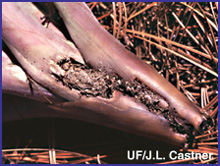
Florida's rarest endangered native bromeliads (airplants) Catopsis nutans, C. berteroniana, Guzmania monostachia, Tillandsia pruinosa, and T. flexuosa are in imminent danger as populations of a non-indigenous weevil encroach on the Everglades area. Florida populations of Tillandsia utriculata, which was common and widespread, have been so devastated that this species, too, has been placed on the list of endangered species (Florida Administrative Code, Chapter 5B-40 2000). The only realistic way of controlling the weevil populations is by biological control, and funding for the research and implementation program into biological control is woefully inadequate.
This weevil, Metamasius callizona, is native to southern Mexico and Central America, was detected in a nursery in Broward County, Florida in 1989 and became feral in that county. By natural spread and by human transport of infested plants it occupied by December 2000 parts of at least 16 Florida counties: Brevard, Broward, Charlotte, Collier, DeSoto, Glades, Hendry, Highlands, Indian River, Lee, Manatee, Martin, Palm Beach, Polk, St. Lucie, and Sarasota.

Fig. 1. A dead Tillandsia utriculata plant, one of thousands killed by Metamasius callizona
in Broward County Parks.
Damage is caused mainly by the weevil larvae which mine the meristemmatic tissue of these plants to kill them and devastate populations. Although the weevil may be a specialist of the larger Tillandsia species (which provide enough plant tissue for development of its larvae), it also attacks Catopsis and Guzmania. A potential biological control agent (a specialist parasitoid fly) has been discovered in Central America by Dr. Ronald Cave (a collaborator at Escuela Agrícola Panamericana [EAP], a U.S. institution).
Local bromeliad societies in Florida have held plant sales and forwarded enough funds through the Florida Council of Bromeliad Societies (FCBS) to support a very modest research program at the University of Florida. FCBS also supported work by a student at EAP.
The University of Florida allows the program partial use of a laboratory and greenhouse, as well as a small percentage of my time. However, it supplies no funds to pay for survey travel within Florida nor for student labor. Continuing work is needed in Florida on location of weevil populations, culture of its immature stages as laboratory hosts for rearing and testing of biological control agents, and foreign travel to collect biological control agents and bring them to Florida for testing.
The program is endorsed by the Florida Endangered Plant Advisory Council. It has been featured in the Palmetto (Quarterly Magazine of The Florida Native Plant Society) Vol. 19 no. 4. Recently, the program has received partial funding from the Florida Department of Agriculture and Consumer Services/Division of Plant Industry (DOACS/DPI). However, the funding is limited and may not be enough to complete the project, depending on how long the research takes.
Read more about this program on the
Save Florida's Native Bromeliads Project Web site
Read More About this Weevil Pest
If you can help with funds for research, pleased contact Save Florida's Native Bromeliads Project Director, Florida Council of Bromeliad Societies, 3 Rocky Creek Trail, Ormond Beach, FL 32174. Email: cajat3@cfl.rr.com
revised 11/01